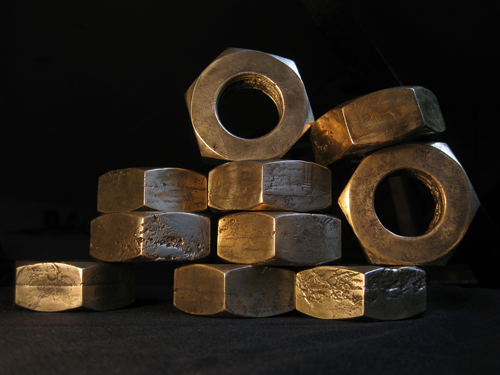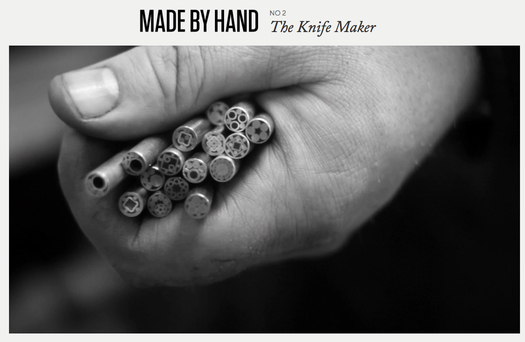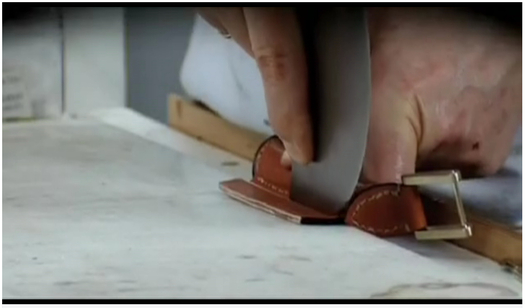
“Ten Bespoke Brass Nuts,” made by Thomas Forsyth, as shown in his video.
A while ago I came upon this video, which shows Thomas Forsyth making “ten bespoke brass nuts.” It lasts almost seven minutes — a fairly detailed and rather slickly produced documentation of a get-your-hands dirty making process, featuring an obviously skilled craftsman. It invites the viewer to appreciate how these strangely beautiful things were made. What was less clear, to me at least, was why they were made. But possibly I was missing the point of the point of the maker-video genre.

A moment in a video of Thomas Forsyth making “Ten Bespoke Brass Nuts.”
And there’s no question that such videos are a kind of genre by now, as I found when I fell down the rabbit hole of stuff-make clips while in the process of doing some stories-and-objects research recently. In this video, we see a man making a “Tradition Double Document Case,” sold by Dunhill. Here is a video about a maker of ornamental glass signs. Similar videos are the main attraction at a site called Made By Hand; here’s one about a knife-maker, in Brooklyn. Here’s a brief video about a tie-maker, via fuckyeahmadeinusa.tumblr.com, which collects similar material. The web site of premium denim brand 3x1 featuers a maker-y video highlighting the on-site mini-manufacturing facility within its downtown New York store. That’s just a sampling.
These videos tend to be very well produced, and are often impressive. At the same time, what I really learned in looking at these clips is that I find the genre profoundly uninteresting. Why?
As stories, they are all the same: This thing is special because of the way it was made, and (usually) because of the skill/passion of this person who made it. The unspoken premise is that there is a class of consumer craving “the story behind” the object. The further premise is that this class of consumer is expanding all the time; more people want to know more about the things they buy, and so on, because global manufacturing culture has alienated us from our objects. Actually, this premise often is spoken. The knife-maker, in explaining the satisfaction of making something useful, mentions “the details” that make his objects superior to those made quickly “in Germany, by ten different robots.”

From Made By Hand, a video about a knife-maker, in Brooklyn
To keep it simple, let’s just say that some version of all this is true: “We” want a more personal connection to “our” things, by way of a creation story. What’s odd is that these videos not only repeat the same story, they tend to do it the same way. This Core77 post sums up the usual aesthetic tactics: “shallow field of focus lovingly lingering on tools, poignant voiceover with a few piano chords in the background, off-center subject slowly coming into focus while staring earnestly into the camera.” In other words, the basic vernacular of the variety of Budweiser Super Bowl ad that touts heritage and choice ingredients of blah blah blah.
By and large, we don’t really learn how these things are made. As I studied the lovingly-lingered-upon tools in the knife-maker’s video, for instance, I wondered: What exactly are they? What does each one do, and how does their use add up to a definitively better knife? How does one go about learning to use, or even acquiring, such tools? Were they made by ten robots in Germany?
That Core77 post praised the Dunhill case video for breaking with the usual maker-video tropes, via brisk editing and no score or voiceover. Fair enough, but I still had to take the clip’s word for it that I was witnessing “techniques that have taken generations to perfect, skills that take years to master.” The post also mentioned something the clip left out: this object costs $3,200. Another notable feature of the “story behind the object” video, actually, is that price is pretty much never mentioned.

From a video that shows the making a “Tradition Double Document Case,” sold by Dunhill.
That seems a little out of sync with the idea that maker stories respond to a new hunger for transparency. But it brings me back to my having originally missed the point of these videos: They’re not about transparency at all, they’re about mystification. They forward the romance of the maker, titillate the viewer with the beautiful magic of making, evoke awe at evidence of passion, craft and skill. The appeal is emotional, and it has to be. The rational story of a thing made really means very little on its own. It matters only secondarily to the emotional story of a thing desired — and then a thing possessed.
The reason I find the genre uninteresting is that it tends to take as its subject matter objects for which I am not in the market. The only way I would care about a hand-made knife is if it happened to be my hand-made knife, and I was therefore in a position to tell you the story of its making, which on some level I would not merely be relating but in effect appropriating. Because what I would really be telling you is the story of me owning an object with an interesting creation story.
Frankly, I needn’t tell you the story, because even when that’s what I’m doing, my real audience is myself: The object is a prop in the story of me, and that is a story I am telling myself all the time. And when I say me, myself, and I, what I mean, of course, is pretty much everyone.


Comments [6]
" it cannot escape attention that there are curious parallels between manuals on sexual techniques and manuals on the preparation of food; the same studious emphasis on leisurely technique, the same apostrophes to the ultimate, heavenly delights. True gastro-porn heightens the excitement and also the sense of the unattainable by proffering colored photographs of various completed recipes. The gastro-pornhound can, in the Bocuse book for example, moisten his lips over a color plate of fresh water crayfish au gratin à la Fernand Point. True, you cannot get fresh crayfish in the United States or indeed black truffles, three tablespoons of which, cut into julienne, are recommended by Bocuse. No matter. The delights offered in sexual pornography are equally unattainable. "
http://www.nybooks.com/articles/archives/1977/dec/08/gastro-porn/?pagination=false
05.20.12
10:21
I find it interesting that you refer to these videos as a "genre" seeing as that seems to place them within the world of cinema. As beautiful as these pieces tend to be, I cannot see them as anything more than marketing and as a result, their prevalence as of late seems to me less "genre" and more mere "trend".
This difference in classification also addresses your opinion of them as uninteresting, that they take for their subject matter an object for which "I am not in the market". For these videos were never designed for you and I to group together as a genre and watch en masse. They are individual productions made specifically to market a particular object to a potential buyer. In this scenario, this video exists separately from all of its maker-clones, a lone beacon in its respective industry, presumably providing the company that paid for it a unique advantage over its competitors.
Whatever the case, any marketing trend that treads this close to authenticity and beauty and promotes the values of hand made quality over factory produced chintz cannot be a bad thing. That said, there is always a shark tank waiting to be jumped...
05.21.12
03:08
bro0me: I don't really disagree with your main point here. I do think that it was the process of gathering stuff up and considering it together that clarified the matter for me. I'm not so sure that saying "genre" elevates these videos, per se. But am sure that "a shark tank waiting to be jumped" is a nice phrase!
05.23.12
05:05
An experiment in design history methodology, she remade Rietveld's red and blue chair to explore the notion of original vs. copy in design. Can copying be its own creative act?
06.02.12
05:52
06.04.12
08:52
06.08.12
07:29